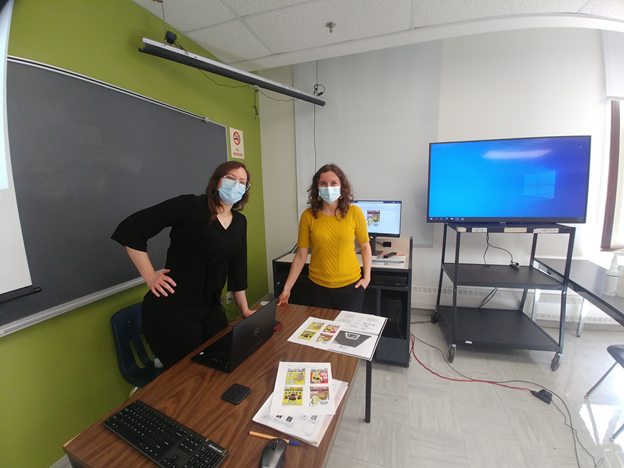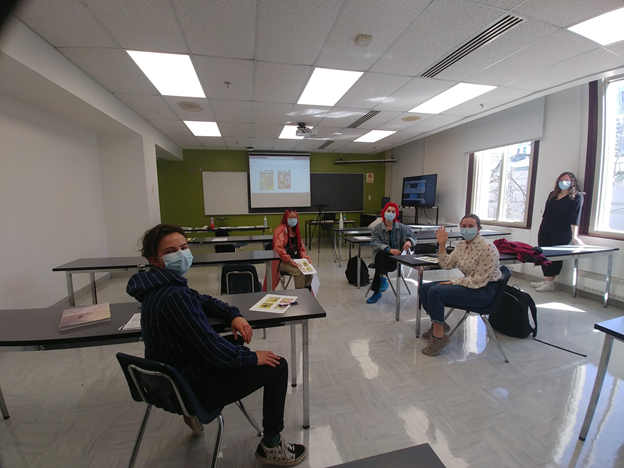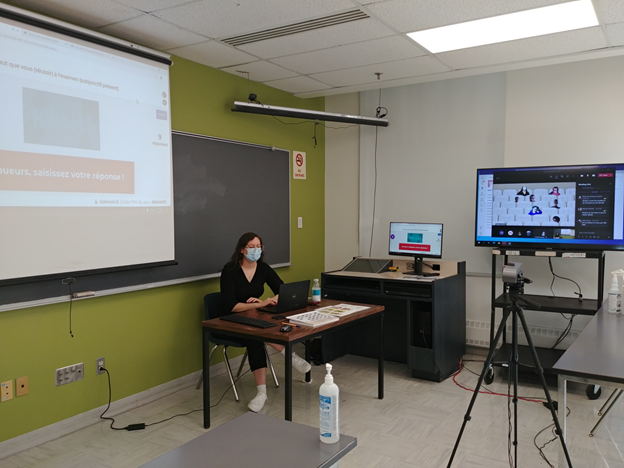The Role of Assistant in The HyFlex Classroom
Have you ever experienced HyFlex teaching? Handling, all at the same time:
- face-to-face students
- remote students
- chat
- cameras
- screen sharing
- etc.?
It is difficult, if not impossible, for a teacher to teach, “put on a performance” and deliver the content effectively at the same time. The presence of a teaching assistant can make all the difference.
Far from being superfluous, the role of the teaching assistant is crucial in the design and delivery of a HyFlex course.
In the winter of 2021, Dawson College made it possible for instructors to teach HyFlex classes: to teach simultaneously to in-person students and to students connected by videoconference. I raised my hand enthusiastically, happy to be able to meet with some of the students, even if only for a limited number of meetings.
I was very lucky to have the support of Julieta Torres, a language lab technician at the College. As the language lab was closed during the pandemic, Julieta was available to act as an assistant during my classes. Thanks to her, I was able to really feel like I was teaching, without all the logistical challenges of HyFlex teaching.
My experience with Julieta has convinced me of the crucial role of an assistant in HyFlex teaching. In this text, I will summarise the main tasks that a HyFlex classroom assistant participates in, more specifically in managing the technical equipment and communications in a virtual classroom.
Setting up equipment and materials
Before the course, visit the HyFlex room with the person who will be assisting you, to discuss the equipment available and take note of the required set-up. Together, test the
- projector
- television and other screens
- cameras
- microphones
- keyboards and mouse devices.
- course platform (in my case it was Microsoft Teams).
Also taking the position of the cameras into account, decide where everyone should sit and how they should move around depending on the activity.
It goes without saying that the person assisting you should be familiar with the platform and applications you are using (Teams, Moodle, etc.). Give them the lesson plan beforehand so that they have an idea of the course flow and the technical challenges.
It is best if the assistant brings a laptop and connects to the video conference to be able to see what a student at home sees. This is what Julieta did. This allowed us to check at any given time that:
- the students in the virtual classroom could see me and the classroom well
- the screen sharing was working properly
- a video being played was seen and heard by everyone
- the pages being displayed on the screen were the correct size
Julieta and I shared the wireless mouse and keyboard on the main screen in the room. In this way, Julieta was able to make the necessary display adjustments for the course when I was too busy to do so, for example, when I was facilitating a discussion between the online and in-classroom students. She was also able to open computer windows ahead of certain activities.
Managing communication in the HyFlex classroom
Alert the teacher that students wish to speak
During large group discussions that require the simultaneous participation of students in attendance and online, scan the TV screen where you can see the remote students, as well as the camera in front of you and your classroom.
Your assistant can help manage turn-taking by letting you know that someone is raising their hand in the video conference or that a student has written in the chat. The assistant can read a comment in the chat if you are too far away to make out the words on the screen. In this way, no one is left out and it ensures that remote students receive the same attention as those in the classroom.
The presence of an assistant makes the HyFlex classroom more inclusive: participants are better integrated, no matter where they are or what means of communication they use (oral or written).
Managing the cameras during discussions
To liven up the discussion, when you are assigning turns or commenting on students’ contributions, the person assisting you can manage the cameras so that the students at home can see both those speaking in the room and the teacher at the blackboard.
In my classroom, Julieta alternated the video source between the camera pointing at the room and the one pointing at me. On my own, I would have found it difficult to carry out this task. The exchanges would have been slowed down and communication would have been interrupted too often. Thanks to Julieta’s help, the students at home could follow the thread of the discussion better by seeing the speakers talking. The camera pointing to the room that I had for my classes did not take close-ups, but it conveyed the classroom atmosphere to my remote students. When I was a bit far from the camera, Julieta would zoom in on me. This way I could move around the classroom more spontaneously, as I was sure that the camera would follow my movements.
Finally, for you and the students in the classroom to see the students in the video conference better, the assistant can use features such as Teams Spotlight, which allows you to highlight a specific speaker in the virtual room.
These few tricks will help improve the fluidity of the exchanges and ensure an authentic communication situation.<3p>
Managing the chat
When I explicitly asked for participation in the chat and there were many responses, Julieta could scroll back into the discussion on her own computer and read some of the students’ responses aloud, if they were no longer visible on the TV. Indeed, if I moved forward to better distinguish the letters on the screen, I would go out of the camera’s field of view and the remote students would no longer see me. This meant that I could not always make out the letters in the chat.
Throughout the course, Julieta was there to let me know if I missed an important comment in the chat (questions, technical problems encountered by students, messages to the teacher). Occasionally, she would also add in the chat information that I gave verbally, such as the code for a Kahoot-type questionnaire or where to find a document.
Managing the display mode
During a HyFlex course, you often must juggle several windows open on your computer at the same time as you speak to your group. During screen sharing, your assistant can quickly confirm that students can see the document clearly and, if necessary, suggest that you optimise the display by using full screen mode or by moving windows around.
When using certain applications (such as Kahoot), the assistant can also correct the display by borrowing your mouse while you are interacting with the students.
Finally, the assistant can take screenshots or make recordings if necessary.
Who can act as an assistant?
Julieta Torres, who assisted me in the winter of 2021, is a technician in the language lab at my college. She was available for all my classes as the lab was closed during the pandemic. However, I think that a teacher’s assistant, in HyFlex settings, does not necessarily have to be a technician. It could also be a student who has taken the course in the past or a tutor working in the college.
However, the assistant’s job implies that they share a certain rapport with the teacher. So, choose someone you get on well with and trust (like Julieta, for me!).
What if no one is there to assist you?
Of course, the tasks done by the assistant are theoretically doable by a teacher alone. However, we should not forget that we are only human, that we do not have 2 pairs of eyes or 4 hands and that our ability to multitask has its limits, both on a cognitive and on a material level.
During the teaching sequence, the assistant enables a fluid exchange that is very similar to the one you can have in a classroom, whether face-to-face or remote:
- You can convey much more content in less time.
- You can also rediscover the pleasure of a communication that is rarely interrupted (except when the assistant signals a post), a bit like the voice in a journalist’s earpiece or the moderator who takes part in a videoconference).
- Students’ attention is not diverted, because you are not repeatedly asking them, “Do you see my screen share correctly?”, “Can you hear the sound of the video?”, “Can you see what the room camera is showing?” At the same time, students can happily do without all the monologues from the teacher explaining what they are doing and what they are going to do: “I’ll see if anyone has written in the chat room”, “I’ll open a new window”, “Why can’t we hear?”, etc.
The outcome of having an assistant is an improvement in the efficiency of student-teacher communication and a maximisation of class time.
What I wish for the future based on my experience
In my opinion, the role of the teaching assistant is essential to the success of HyFlex courses.
An assistant enables a teacher to deliver quality HyFlex teaching by:
- ensuring an authentic communicative situation
- avoiding unnecessary time wasting that sometimes forces the teacher to sacrifice relevant content
- considerably reducing the stress that the teacher might feel in the face of the overwhelming techno-pedagogical demands that this type of teaching imposes.
I loved my experience with Julieta, but I could not see myself teaching a HyFlex class without assistance. On my own, I would not be able to offer sufficiently interactive and dynamic teaching. The motivation and success of the students would undoubtedly suffer. If HyFlex teaching continues in CEGEPs after the end of the pandemic, I sincerely hope that all teachers who wish to do so will be able to count on the presence of an assistant in class. The success of the formula depends on it, in my humble opinion!




